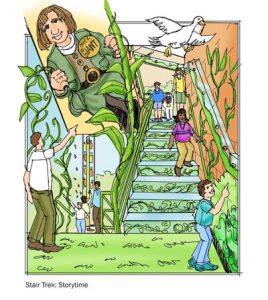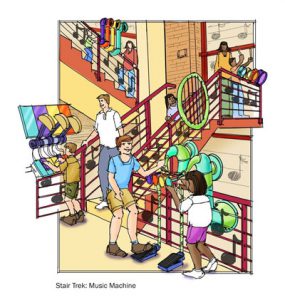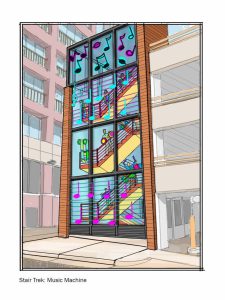- Home Test 625
- Home
- Visit
- Exhibits
- Programs & Events
- Membership
- Support
- Give the Gift of Play
- About
- Checkout
- Cart
- Utility
- Birthday Party Cancellation Form
- Phone Call
- Request for a Facility Rental Agreement
- Privacy Policy
- American Girl Benefit Sale
- Party Catering Form
- Event Date Request Form
- Camp Food Orders
- Flourish!
- IA24 Evening Event RSVP
- Development Events RSVP
- Development Tour
- Folder Request Form
- Development Team Test Page
- Logout
- Birthday Parties
Creating stairwells a step above the rest
InBusiness Madison
BY JASON BUSCH
While not actual plans for the Madison Children’s Museum’s own stairwell spaces, concept drawings like the ones throughout this article offer a general sense of what is possible in a transformed space.
Included among many of the wellness initiatives adopted by businesses over the last several years are recommendations that employees take time each day to step away from their desks and move around.
One easy way that’s often cited for people to get a little extra exercise without a lot of effort is taking the stairs as opposed to elevators or escalators. Unfortunately, while stairs are heavy on function, they’re usually light on form. In short, they’re not inviting. A new initiative underway at the Madison Children’s Museum is seeking to change that, and it offers some ideas that local businesses can incorporate into their own facilities to encourage employees to get off their butts.
With gaining momentum and financial supporters, the Madison Children’s Museum (MCM) aims to make area stairwells inspiring and joyful places. Work on the project began after the museum won a competitive matching grant of $148,000 from the Institute of Museum and Library Services. These “Design to Move” projects will improve the health of the community through innovative collaborations between city officials, artists, designers, and health professionals. The initiative is housed in and coordinated by MCM, with help from many project partners.
According to Jonathan Zarov, MCM director of marketing and communications, the museum launched an exhibit called the Funkyard (since replaced by a mural exhibit) in its back lot a few years ago. The exhibit environment encouraged active play, with scooters, jump ropes, and more. It was very popular, notes Zarov, and museum staff saw the benefits that came from kids moving and playing together.
So MCM staff began looking at other options for active play in the museum, while at the same time taking pressure off its main elevator, which serves four floors. As staffers researched ways to get people to take the stairs, Zarov says they found projects from around the world where fantastic stairwells had been created – and people actually enjoyed using.
“We decided that this was a great opportunity to use art to make our stairwells a destination and playful experience — a place people would look forward to visiting, much like the bathrooms at the Kohler Art Museum,” explains Brenda Baker, MCM director of exhibits.
As the project grew, MCM found partners interested in improving community health, which is one of the ultimate goals of the project.
Transforming stairwells is the first major initiative of Design to Move — dubbed Stair Trek. Plans include makeovers of all three stairwells at the Madison Children’s Museum: a staff stairwell that will include incentives encouraging MCM employees to take the stairs; Core to Cosmos, a public stairwell that will take visitors on an upward journey from the earth’s fiery core into space; and a second public stairwell that will employ area artists to improve the stairway experience.
Out in the community, MCM and partners will work to transform about a half dozen stairwells, mostly in public and residential areas that serve diverse audiences. Site locations are currently being finalized. Funding from the KaBOOM! Play Everywhere Challenge supports most of these projects.
MCM is currently talking to prospective donors about funding the matching portion of the IMLS grant. “We are looking for a few deep partnerships with businesses or individuals who are similarly enthusiastic about using good design to encourage healthy behaviors,” notes Dani Luckett, MCM director of development.
Currently planned Stair Trek exhibits are scheduled to roll out from January to May of 2017.
Related programming at the museum and out in the community will complement the Stair Trek exhibits.
Something to stare at
Sure, improving the appearance of stairwells sounds great, but how much can really be done using the stairs inviting once the novelty has worn off?
Zarov acknowledges the limitations inherent in stairwells, but notes there’s still plenty of opportunity for creativity and flexibility to keep the spaces fresh.
Two key partners on the initiative are the Madison Fire Department and the Healthy Kids Collaborative. Both signed on to help address what they see as a growing public health threat — inactivity and poor health. In particular, the fire department increasingly handles emergency calls with their Guards for Fire Watch Duties involving health issues that have nothing to do with fires.
The Madison Fire Department is a key partner because they determine what can and can’t be done in stairwells, explains Zarov. The fire department is assisting MCM with the creative redesign of its stairwells without creating safety hazards.
Fire stairwells such as the ones in the museum, pose many constraints. Given the limitations around materials that can be used, sound and light — key elements of Stair Trek: Core to Cosmos — provide better opportunities to transform the stairwells without undergoing major reconstruction. Since manipulating light and sound is a more agile process than changing out walls or structures, there are more opportunities for updating, changing, or including seasonal elements in the exhibits to keep them fresh.
Not just for kids
According to Zarov, studies show there’s more to improving the appearance of stairwells than just keeping kids entertained.
“Good design can be a powerful motivator — and changing the environment can change behaviors,” notes Baker. “We’re betting that more playful, engaging environments will get people moving and result in better health.”
There’s evidence to back that up. Studies from the Center for Disease Control and Prevention have found that by enhancing the appearances of stairwells, businesses have increased stair use by more than 50%.
The CDC’s own project, “StairWELL to Better Health,” used a similar approach to Design to Move to make stairwells more attractive and increase use. Zarov says the CDC carefully tracked the results over three and a half years and concluded that the effort was successful.
MCM staff hopes the Design to Move project becomes a local movement about movement, and see opportunities for other local businesses to hop on the bandwagon.
“We invite area business leaders and their teams to come and visit us at the museum,” says Luckett. “We’d be happy to give tours and welcome opportunities to partner, formally and informally. Our corporate partners and sponsors are key to the museum’s annual operations and critical to making special projects, like Design to Move, possible.”
The scope and reach of the project is limited only by the number of steps in the community and the imaginations of their stewards. Design to Move seeks to catalyze more stairwell transformations by providing a toolkit that will offer resources for organizations wanting to improve their own stairwells.
According to Zarov, for local businesses interested in transforming their own stairwells, the museum’s grant includes funding for the toolkit, which makes it possible to do the work without a formal partnership with the project. The toolkit, which will be launched in 2017, will provide ideas, design templates, resources, and other information.




